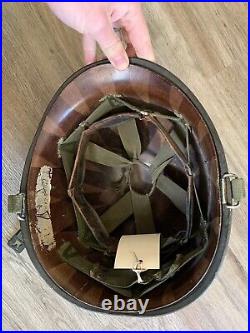Rare Korean War 2nd Infantry Dutch UN Forces 2 Helmets / Liners








Decorated with the American Presidential Unit Citation, Combat Infantry Badge, the UN Service Medal, and the Dutch Cross for Justice and Freedom, untouched and original. Helmets are original and included with the uniform but were not originally paired to it.
The shell is dated to 1945 and the liners from the Korean War time period. During the Korean War the Netherlands UN infantry forces were attached to the 2nd infantry division starting in 1950. Only 3,972 Dutch soldiers served in Korea making this an extremely rare uniform. Many of these soldiers already had combat and anti Guerilla experience from serving in the Dutch East Indies and from the Second World War.The first battalion of Dutch UN soldiers numbered 636 men, they were placed under the Netherlands Royal Army "Van Heutsz" regiment, and from there attached to the 38th regiment of the 2nd Infantry Division, 8th Army. During the failure of Operation Roundup, which saw to push the Chinese and North Koreans back north, the South Korean army was fleeing en masse while the Americans and the small Dutch battalion had to cover the retreat out of what would be called massacre valley. The chaos of the retreat left the Dutch unit open on their right flank which the Chinese soldiers exploited and with the call of bugles lead an attack that would decimate the officers of the unit. Later in the battle while attempting to hold Hill 325 the Dutch unit employed their cooks, drivers and typists to help launch two unsuccessful attacks on the communist forces, but on the 3rd attempt managed to take the hill. After sustaining these heavy losses they were brought off the front lines for two months to rest.
The original battalion was sent home by September 1951 and replacements arrived. In October these replacements troops were tasked to clean up the captured ground.
Destroying enemy resistance in the day and at night conducting ambushes on enemy positions in hiding. From April to July 1952 the Dutch troops were pulled from the lines to serve as prison guards of captured communist soldiers on the island of Kojedo. In 1953 the Dutch soldiers were stationed directly on the 38th parallel where they had to fend off numerous attacks from the Chinese PLA. After the end of the war the soldiers remained in Korea until being relieved by the US in September of 1954.